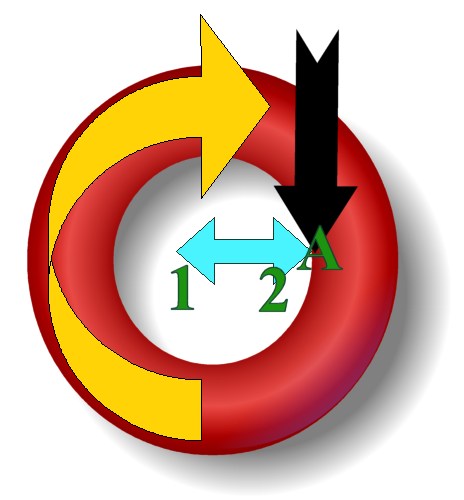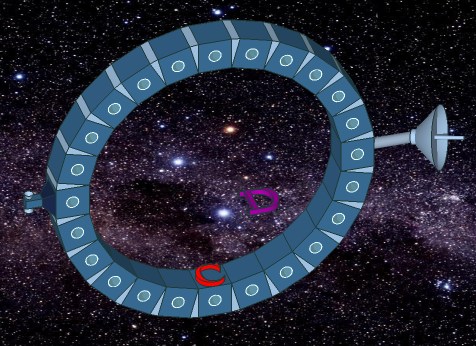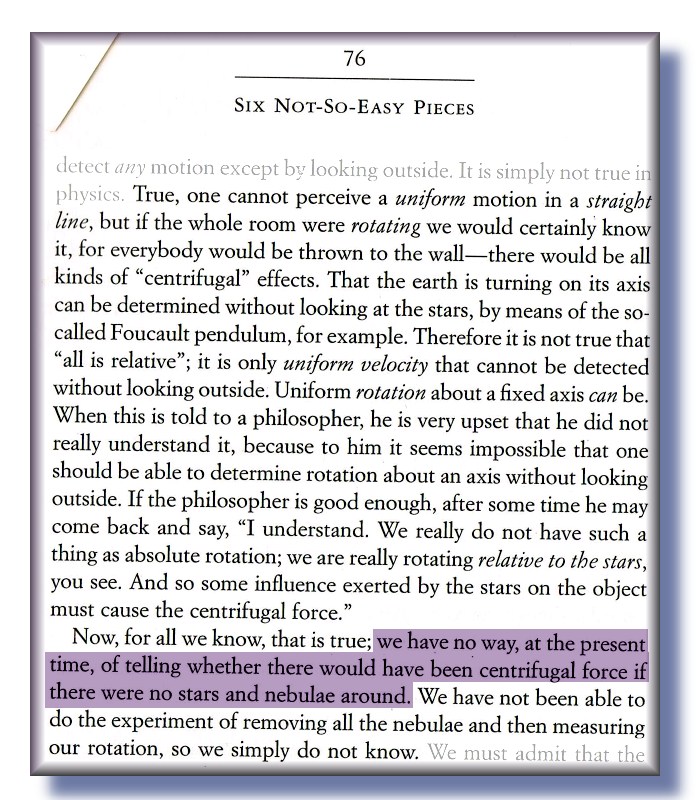|
Centrifugal Force |
| As I read the esteemed Richard P. Feynman I find that basic misconceptions are offered as regards, my pet topic of spin. Before you read his account of the centrifugal force, let me give my own observation as to why the centrifugal force occurs. |
| Consider this simple diagram of an object rotating clockwise at a uniform velocity. The point at A is on the surface of the inner rim of the object. The black arrow represents the resultant force that A undergoes due to the object spinning. If A was on the outer rim, it would be thrown off in the direction of the black arrow. But as A is on the inner rim, the turquoise arrow represents the resultant tension exhibited by the molecular forces of the object on A due to friction. A wants to move down, but due to the curve of the red surface, it is pulled to the left (1), and it feels a force pulling back at it (2) which is the typical centrifugal force. This seems fairly obvious. But let me take it further. |
| B is a typical fairground attraction. A person at position B is pulled to the inner rim by the force of the spinning object acting on the air through friction. The air in contact with the surface wants to move in the same manner as the black arrow in diagram A. But due to the air being in contact with other air which is in contact with the rim, all the air within the spinning object is subject to the centrifugal force. The air nearest the middle of the circle experiences less centrifugal force due to the rotational velocity being less. The inner rim forces the air into a circle so anything in contact with the air is pulled along with it. This is why one sticks to the rim at the fairground. The air inside the spinning object is behaving according to the same set of vectors as A. Eventually as the spin increases, gravity itself is not as strong as the force of the air sticking the person to the inner rim at position B and so gravity is overcome. The only differences between B and A is that gravity is overcome in B, and the role of the air is taken into account. Friction against the inner rim does all the work through the medium of the air. Now carefully consider the effects at the spinning space-station: C and D in deep space. |
| There is no force of gravity present and there is no air. A person at position D will not feel the centrifugal effect unless they come into contact with the space station like at C. This is because there is no air to be pulled along with the rotation as it comes into contact with the inner rim. So if the person is standing on the rotating inner rim, they will stick to it because of the centrifugal force described by the vectors previously at A. Just like the black arrow in A, the centrifugal force will push the astronaut C down, against the space station and the blue tension arrow then pulls back at them, and artificial gravity is the result. There is just no way that a person floating in space at D will feel any centrifugal force. If the person floating in position D is not in contact with the space station, she will feel nothing However, friction will hold her to the inner rim if she is in contact with it at C. (The stars and nebulae surely have nothing to do with it! Take note of this!) It is just a vector calculation that requires one to try and envision what the invisible air (or lack thereof) is doing according to normal Newtonian calculations. Ah! Good old Newton; always reliable and vindicated to the end. It seems that the other theorists neglected the role that the air plays because it is invisible. If the space station starts to accelerate and then slowly spins from a stationary point, and the astronaut is in contact with the inner rim of the space station, then she will start to feel the centrifugal force. She will be able to stay standing on the inside of the space station as it accelerates. She will still feel the centrifugal force once the acceleration stops and a stable velocity is attained. So there is a force being applied to the astronaut even when there is no acceleration. The Ohanian Physics text book, only offers an account of centrifugal acceleration, and carefully omits any reference to the curious phenomenon of how the centrifugal force is still experienced when a body is spinning at a constant velocity! For a force to be present during acceleration is logical. But as Feynman points out, that a force should be present when velocity is constant (when there is no acceleration), is a bit inexplicable. I was made aware at quite a young age, that there was no valid explanation for the centrifugal force. How is it that a force can be felt when the velocity is constant and no force is being applied? Well, if we add up the force vectors of all the points on the compass, then the result will still be zero! But it seems quite clear to me that it is the friction of the moving inner surface that carries the air (and anything else it is in contact with) along with it; and the rest is a vector sum. So let us turn to Feynman’s account of the centrifugal force. |
| What he means by ‘all kinds of centrifugal effects’ is a good warning that he is unsure of what is occurring. Centrifugal force is simply the normal kind of Newtonian vectors at work, not ‘all kinds’. The highlighted part of his text shows just how weak his comprehension of this basic phenomenon is. Thankfully he maintains his integrity by honestly claiming not to understand it. Astounding! After this he then goes on to describe Einstein’s Special theory of relativity, which is surely one of the most complex counter-intuitive ideas offered by the ‘scientists’. After reading that terrible account of the centrifugal force, I am now compelled to do something I was avoiding. That is, I will take on Einstein’s Special Theory of Relativity and very clinically and critically deconstruct it, piece by piece... (in the final chapter). Feynman’s inability to deconstruct the quite simple centrifugal phenomenon puts a great burden on me to not at all swallow Einstein’s Special Theory of Relativity, simply because Feynman and Einstein said it is true; and, the theory is complex. If Feynman can get the quite simple vector arithmetic of the centrifugal force so wrong, then how can I assume that he understands Relativity at all? It is highly likely that Einstein and most of those that portend to ‘scientific orthodoxy’ have also missed the obvious math of the friction of the air, and so it is with a further sense of trepidation that I have to view all of Relativity in the same sorry light. I almost wish had not read that above quote of Feynman, for the implications are deeply troubling to my person. Nonetheless as a positivist I can only shudder at all the scorn that the Emperor’s naked entourage, however vast and full of titles it may be, will now project at me for doubting Relativity’s authenticity; and they will throw ever increasingly complex hyperbolic calculations at me too! But I have been contemplating Relativity since the age of about 10, and always suspected there was something not quite right with it. Moreover, the concept of relative time clashes badly with quantum time; and my computer agrees with the latter, but to get it to do the former would require two separate dimensions of time in the simplest form, one within the other. And even then it is doubtful that the two ideas will work neatly together. In reality there would need to be a different dimension of time for every particle in the universe. |
| This
analysis continues here: Relativity Revised - Deconstruction of Special Relativity |
| Latest
Article: Gravitational Waves & General Relativity - A Computational Analysis |
< top >
< seti >
< why? >
< credits >
< dark matter >
< dark energy >
< binary orbits >
< the big unwind >
< contact details >
< force of gravity >
< zeno and planck >
< quantum gravity >
< bin laden helicopter crash >
< how the solar system formed >
< gravitational waves & general relativity >
< why the moon is receding from the earth >
< why the moon is red during a lunar eclipse >
< summary of rotation curves of spiral galaxies >
< rubin's problem - rotation curves of galaxies - rubin's problem animated - oscillations in spiral galaxies >





